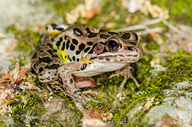|
Rana palustris LeConte, 1825
Pickerel Frog Subgenus: Pantherana | family: Ranidae genus: Rana |
|
Taxonomic Notes: This species was placed in the genus Lithobates by Frost et al. (2006). However, Yuan et al. (2016, Systematic Biology, doi: 10.1093/sysbio/syw055) showed that this action created problems of paraphyly in other genera. Yuan et al. (2016) recognized subgenera within Rana for the major traditional species groups, with Lithobates used as the subgenus for the Rana palmipes group. AmphibiaWeb recommends the optional use of these subgenera to refer to these major species groups, with names written as Rana (Aquarana) catesbeiana, for example. |
|
 © 2012 John P. Clare (1 of 50) |
|
|
|
Description Distribution and Habitat Country distribution from AmphibiaWeb's database: Canada, United States U.S. state distribution from AmphibiaWeb's database: Alabama, Arkansas, Connecticut, District of Columbia, Delaware, Georgia, Iowa, Illinois, Indiana, Kansas, Kentucky, Louisiana, Massachusetts, Maryland, Maine, Michigan, Minnesota, Missouri, Mississippi, North Carolina, New Hampshire, New Jersey, New York, Ohio, Oklahoma, Pennsylvania, South Carolina, Tennessee, Texas, Virginia, Vermont, Wisconsin, West Virginia Canadian province distribution from AmphibiaWeb's database: New Brunswick, Nova Scotia, Ontario, Quebec
North of the coastal plain boundary, it occurs in habitats where the water is cool and clear. On the Coastal Plain, it occurs in floodplain swamp habitat, while in karst topography, it is often confined to the vicinity of the cave mouth. Life History, Abundance, Activity, and Special Behaviors
References
Fenolio, D.B., Graening, G.O., Stout, J.F. (2005). ''Seasonal movement pattern of pickerel frogs (Rana palustris) in an Ozark cave and ecological implications supported by stable isotope evidence.'' The Southern Naturalist, 50(3), 385-389. Schaaf, R. T., Jr., and Smith, P. W. (1963). ''Rana palustris (LeConte). Pickerel Frog.'' Catalogue of American Amphibians and Reptiles. American Society of Ichthyologists and Herpetologists, 117.1-117.3. Originally submitted by: Franziska Sandmeier (first posted 2001-02-21) Edited by: Shakil Huq, Michelle S. Koo (2023-10-23) Species Account Citation: AmphibiaWeb 2023 Rana palustris: Pickerel Frog <https://amphibiaweb.org/species/5121> University of California, Berkeley, CA, USA. Accessed May 17, 2025.
Feedback or comments about this page.
Citation: AmphibiaWeb. 2025. <https://amphibiaweb.org> University of California, Berkeley, CA, USA. Accessed 17 May 2025. AmphibiaWeb's policy on data use. |




 Map of Life
Map of Life